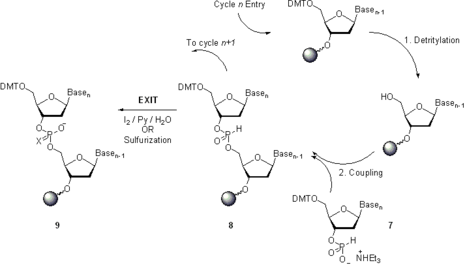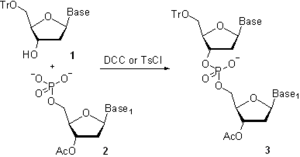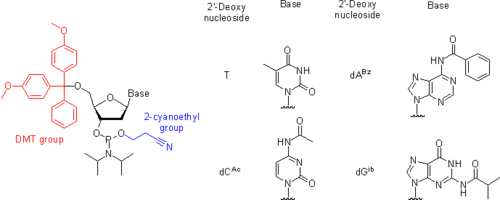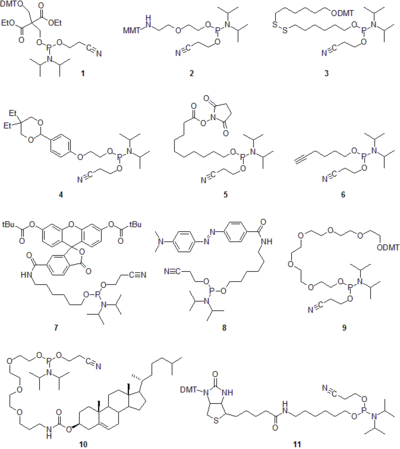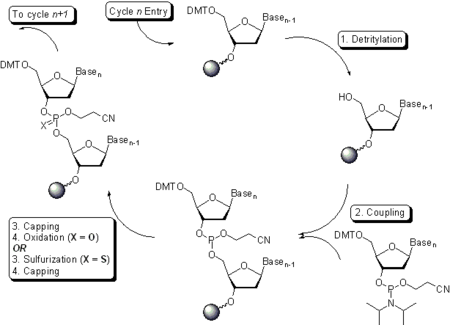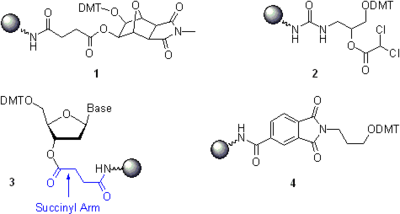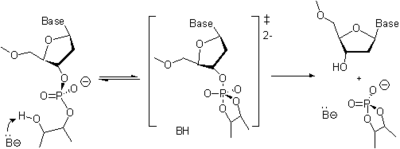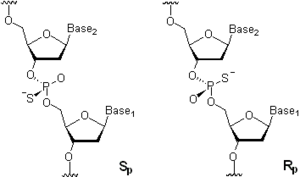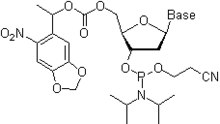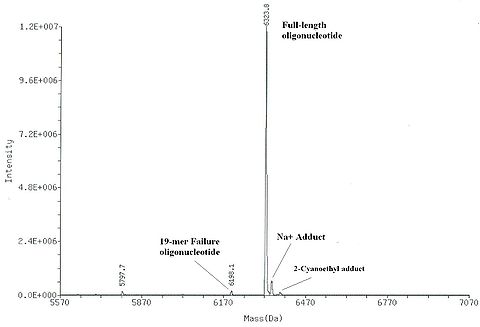- Oligonucleotide synthesis
-
Oligonucleotide synthesis is the chemical synthesis of relatively short fragments of nucleic acids with defined chemical structure (sequence). The technique is extremely useful in current laboratory practice because it provides a rapid and inexpensive access to custom-made oligonucleotides of the desired sequence. Whereas enzymes synthesize DNA and RNA in a 5' to 3' direction, chemical oligonucleotide synthesis is carried out in the opposite, 3' to 5' direction. Currently, the process is implemented as solid-phase synthesis using phosphoramidite method and phosphoramidite building blocks derived from protected 2'-deoxynucleosides (dA, dC, dG, and T), ribonucleosides (A, C, G, and U), or chemically modified nucleosides, e.g. LNA. To obtain the desired oligonucleotide, the building blocks are sequentially coupled to the growing oligonucleotide chain in the order required by the sequence of the product (see Synthetic cycle below). The process has been fully automated since the late 1970s. Upon the completion of the chain assembly, the product is released from the solid phase to solution, deprotected, and collected. The occurrence of side reactions sets practical limits for the length of synthetic oligonucleotides (up to about 200 nucleotide residues) because the number of errors accumulates with the length of the oligonucleotide being synthesized.[1] Products are often isolated by HPLC to obtain the desired oligonucleotides in high purity. Typically, synthetic oligonucleotides are single-stranded DNA or RNA molecules around 15–25 bases in length. They are most commonly used as antisense oligonucleotides, small interfering RNA, primers for DNA sequencing and amplification, probes for detecting complementary DNA or RNA via molecular hybridization, tools for the targeted introduction of mutations and restriction sites, and for the synthesis of artificial genes.
Contents
- 1 History
- 2 Synthesis by the Phosphoramidite method
- 3 Post-synthetic processing
- 4 Characterization
- 5 References
- 6 Further reading
- 7 See also
History
The evolution of oligonucleotide synthesis saw four major methods of the formation of internucleosidic linkages and has been reviewed in the literature in great detail.[2][3][4]
Early work and contemporary H-phosphonate synthesis
In the early 1950s, Alexander Todd’s group pioneered H-phosphonate and phosphate triester methods of oligonucleotide synthesis.[5][6] The reaction of compounds 1 and 2 to form H-phosphonate diester 3 is an H-phosphonate coupling in solution while that of compounds 4 and 5 to give 6 is a phosphotriester coupling (see Phosphotriester synthesis below).
Thirty years later, this work inspired, independently, two research groups to adopt the H-phosphonate chemistry to the solid-phase synthesis using nucleoside H-phosphonate monoesters 7 as building blocks and pivaloyl chloride, 2,4,6-triisopropylbenzenesulfonyl chloride (TPS-Cl), and other compounds as activators.[7][8] The practical implementation of H-phosphonate method resulted in a very short and simple synthetic cycle consisting of only two steps, detritylation and coupling (Scheme 2). Oxidation of internucleosidic H-phosphonate diester linkages in 8 to phosphodiester linkages in 9 (X = O) with a solution of iodine in aqueous pyridine is carried out at the end of the chain assembly rather than as a step in the synthetic cycle. Alternatively, 8 can be converted to phosphorothioate 9 (X = S).
Phosphodiester synthesis
In the 1950s, Khorana and co-workers developed a phosphodiester method where 3’-O-acetylnucleoside-5’-O-phosphate 2 (Scheme 3) was activated with N,N’-dicyclohehylcarbodiimide (DCC) or 4-toluenesulfonylchloride (Ts-Cl). The activated species were reacted with a 5’-O-protected nucleoside 1 to give a protected dinucleoside monophosphate 3.[9] Upon the removal of 3’-O-acetyl group using base-catalyzed hydrolysis, further chain elongation was carried out. Following this methodology, sets of tri- and tetradeoxyribonucleotides were synthesized and were enzymatically converted to longer oligonucleotides, which allowed elucidation of the genetic code. The major limitation of the phosphodiester method consisted in the formation of pyrophosphate oligomers and oligonucleotides branched at the internucleosidic phosphate. The method seems to be a step back from the more selective chemistry described earlier; however, at that time, most phosphate-protecting groups available now had not yet been introduced. The lack of the convenient protection strategy necessitated taking a retreat to a slower and less selective chemistry to achieve the ultimate goal of the study.[2]
Phosphotriester synthesis
In the 1960s, groups led by R. Letsinger[10] and C. Reese[11] developed a phosphotriester approach. The defining difference from the phosphodiester approach was the protection of the phosphate moiety in the building block 1 (Scheme 4) and in the product 3 with 2-cyanoethyl group. This precluded the formation of oligonucleotides branched at the internucleosidic phosphate. The higher selectivity of the method allowed the use of more efficient coupling agents and catalysts,[12][13] which dramatically reduced the length of the synthesis. The method, initially developed for the solution-phase synthesis, was also implemented on low-cross-linked “popcorn” polystyrene,[14] which initiated a massive research effort in solid-phase synthesis of oligonucleotides and eventually led to the automation of the oligonucleotide chain assembly.
Phosphite triester synthesis
In the 1970s, substantially more reactive P(III) derivatives of nucleosides, 3'-O-chlorophosphites, were successfully used for the formation of internucleosidic linkages.[15] This led to the discovery of the phosphite triester methodology. The group led by M. Caruthers took the advantage of less aggressive and more selective 1H-tetrazolidophosphites and implemented the method on solid phase.[16] Very shortly after, the workers from the same group further improved the method by using more stable nucleoside phosphoramidites as building blocks.[17] The use of 2-cyanoethyl phosphite-protecting group in place of a less user-friendly methyl group led to the nucleoside phosphoramidites currently used in oligonucleotide synthesis (see Phosphoramidite building blocks below).[18] Many later improvements to the manufacturing of building blocks, instrumentation, and synthetic protocols made the phosphoramidite chemistry a very reliable and expedite method of choice for the preparation of synthetic oligonucleotides.[1]
Synthesis by the Phosphoramidite method
Building Blocks
Nucleoside phosphoramidites
Main article: Nucleoside phosphoramiditeAs mentioned above, the naturally occurring nucleotides (nucleoside-3'- or 5'-phosphates) and their phosphodiester analogs are insufficiently reactive to afford an expedite synthetic preparation of oligonucleotides in high yields. The selectivity and the rate of the formation of internucleosidic linkages is dramatically improved by using 3'-O-(N,N-diisopropyl phosphoramidite) derivatives of nucleosides (nucleoside phosphoramidites) that serve as building blocks in phosphite triester methodology. To prevent undesired side reactions, all other functional groups present in nucleosides have to be rendered unreactive (protected) by attaching protecting groups. Upon the completion of the oligonucleotide chain assembly, all the protecting groups are removed to yield the desired oligonucleotides. Below, the protecting groups currently used in commercially available[19][20][21][22][23] and most common nucleoside phosphoramidite building blocks are briefly reviewed:
- The 5'-hydroxyl group is protected by an acid-labile DMT (4,4'-dimethoxytrityl) group.
- Thymine and uracil, nucleic bases of thymidine and uridine, respectively, do not have exocyclic amino groups and hence do not require any protection. Although the nucleic base of guanosine and 2'-deoxyguanosine does have an exocyclic amino group, its basicity is low to an extent that it does not react with phosphoramidites under the conditions of the coupling reaction. However, a phosphoramidite derived from the N2-unprotected 5'-O-DMT-2'-deoxyguanosine is poorly soluble in acetonitrile, the solvent commonly used in oligonucleotide synthesis. In contrast, the N2-protected versions of the same compound dissolve in acetonitrile well and hence are widely used. Nucleic bases adenine and cytosine bear the exocyclic amino groups reactive with the activated phosphoramidites under the conditions of the coupling reaction. Although, at the expense of additional steps in the synthetic cycle, the oligonucleotide chain assembly may be carried out using dA and dC phosphoramidites with unprotected amino groups,[24] most often these are kept permanently protected over the entire length of the oligonucleotide chain assembly. The protection of the exocyclic amino groups have to be orthogonal to that of the 5'-hydroxy group because the latter is removed at the end of each synthetic cycle. The simplest to implement and hence the most widely accepted is the strategy where the exocyclic amino groups bear a base-labile protection. Most often, two protection schemes are used.
- In the first, the standard and more robust scheme (Figure), Bz (benzoyl) protection is used for A, dA, C, and dC, while G and dG are protected with isobutyryl group. More recently, Ac (acetyl) group is often used to protect C and dC as shown in Figure.[25]
- In the second, mild protection scheme, A and dA are protected with isobutyryl[26] or phenoxyacetyl groups (PAC).[27] C and dC bear acetyl protection,[25] and G and dG are protected with 4-isopropylphenoxyacetyl (iPr-PAC)[28] or dimethylformamidino (dmf)[29] groups. Mild protecting groups are removed more readily than the standard protecting groups. However, the phosphoramidites bearing these groups are less stable when stored in solution.
- The phosphite group is protected by a base-labile 2-cyanoethyl group.[18] Once a phosphoramidite has been coupled to the solid support-bound oligonucleotide and the phosphite moieties have been converted to the P(V) species, the presence of the phosphate protection is not mandatory for the successful conducting of further coupling reactions.[30]
 2'-O-Protected ribonucleoside phosphoramidites.
2'-O-Protected ribonucleoside phosphoramidites.
- In RNA synthesis, the 2'-hydroxy group is protected with TBDMS (t-butyldimethylsilyl) group.[31][32][33][34] or with TOM (tri-iso-propylsilyloxymethyl) group,[35][36] both being removable by treatment with fluoride ion.
- The phosphite moiety also bears a diisopropylamino (iPr2N) group reactive under acidic conditions. Upon activation, the diisopropylamino group leaves to be substituted by the 5'-hydroxy group of the support-bound oligonucleotide (see "Step 2: Coupling" below).
Non-nucleoside phosphoramidites
Non-nucleoside phosphoramidites are the phosphoramidite reagents designed to introduce various functionalities at the termini of synthetic oligonucleotides or between nucleotide residues in the middle of the sequence. In order to be introduced inside the sequence, a non-nucleosidic modifier has to possess at least two hydroxy groups, one of which is often protected with the DMT group while the other bears the reactive phosphoramidite moiety.
Non-nucleosidic phosphoramidites are used to introduce desired groups that are not available in natural nucleosides or that can be introduced more readily using simpler chemical designs. A very short selection of commercial phosphoramidite reagents is shown in Scheme for the demonstration of the available structural and functional diversity. These reagents serve for the attachment of 5'-terminal phosphate (1),[37] NH2 (2),[38] SH (3),[39] aldehydo (4),[40] and carboxylic groups (5),[41] CC triple bonds (6),[42] non-radioactive labels and quenchers (exemplified by 6-FAM amidite 7[43] for the attachment of fluorescein and dabcyl amidite 8,[44] respectively), hydrophilic and hydrophobic modifiers (exemplified by hexaethyleneglycol amidite 9[45][46] and cholesterol amidite 10,[47] respectively), and biotin amidite 11.[48]
Synthetic cycle
Oligonucleotide synthesis is carried out by a stepwise addition of nucleotide residues to the 5'-terminus of the growing chain until the desired sequence is assembled. Each addition is referred to as a synthetic cycle (Scheme 6) and consists of four chemical reactions:
Step 1: De-blocking (detritylation)
The DMT group is removed with a solution of an acid, such as 2% TCA or 3% Dichloroacetic acid (DCA), in an inert solvent (dichloromethane or toluene). The orange-colored DMT cation formed is washed out; the step results in the solid support-bound oligonucleotide precursor bearing a free 5'-terminal hydroxyl group. It is worth remembering that conducting detritylation for an extended time or with stronger than recommended solutions of acids leads to depurination of solid support-bound oligonucleotide and thus reduces the yield of the desired full-length product.
Step 2: Coupling
A 0.02 - 0.2M solution of nucleoside phosphoramidite (or a mixture of several phosphoramidites) in acetonitrile is activated by a 0.2 - 0.7M solution of an acidic azole catalyst, 1H-tetrazole, 2-ethylthiotetrazole,[49] 2-benzylthiotetrazole,[50][51] 4,5-dicyanoimidazole,[52] or a number of similar compounds. The mixing is usually very brief and occurs in fluid lines of oligonucleotide synthesizers (see below) while the components are being delivered to the reactors containing solid support. The activated phosphoramidite in 1.5 - 20-fold excess over the support-bound material is then brought in contact with the starting solid support (first coupling) or a support-bound oligonucleotide precursor (following couplings) whose 5'-hydroxy group reacts with the activated phosphoramidite moiety of the incoming nucleoside phosphoramidite to form a phosphite triester linkage. The phosphoramidite coupling is very rapid and requires, on small scale, about 20 s for its completion. The reaction is also highly sensitive to the presence of water, particularly when dilute solutions of phosphoramidites are used, and is commonly carried out in anhydrous acetonitrile. Generally, the larger the scale of the synthesis, the lower the excess and the higher the concentration of the phosphoramidites is used. In contrast, the concentration of the activator is primarily determined by its solubility in acetonitrile and is irrespective of the scale of the synthesis. Upon the completion of the coupling, any unbound reagents and by-products are removed by washing.
Step 3: Capping
The capping step is performed by treating the solid support-bound material with a mixture of acetic anhydride and 1-methylimidazole or, less often, DMAP as catalysts and, in the phosphoramidite method, serves two purposes.
- After the completion of the coupling reaction, a small percentage of the solid support-bound 5'-OH groups (0.1 to 1%) remains unreacted and needs to be permanently blocked from further chain elongation to prevent the formation of oligonucleotides with an internal base deletion commonly referred to as (n-1) shortmers. The unreacted 5'-hydroxy groups are, to a large extent, acetylated by the capping mixture.
- It has also been reported that phosphoramidites activated with 1H-tetrazole react, to a small extent, with the O6 position of guanosine.[53] Upon oxidation with I2 /water, this side product, possibly via O6-N7 migration, undergoes depurination. The apurinic sites thus formed are readily cleaved in the course of the final deprotection of the oligonucleotide under the basic conditions (see below) to give two shorter oligonucleotides thus reducing the yield of the full-length product. The O6 modifications are rapidly removed by treatment with the capping reagent as long as the capping step is performed prior to oxidation with I2/water.
- The synthesis of oligonucleotide phosphorothioates (OPS, see below) does not involve the oxidation with I2/water, and, respectively, does not suffer from the side reaction described above. On the other hand, if the capping step is performed prior to sulfurization, the solid support may contain the residual acetic anhydride and N-methylimidazole left after the capping step. The capping mixture interferes with the sulfur transfer reaction, which results in the extensive formation of the phosphate triester internucleosidic linkages in place of the desired PS triesters. Therefore, for the synthesis of OPS, it is advisable to conduct the sulfurization step prior to the capping step.[54]
Step 4: Oxidation
The newly formed tricoordinated phosphite triester linkage is not natural and is of limited stability under the conditions of oligonucleotide synthesis. The treatment of the support-bound material with iodine and water in the presence of a weak base (pyridine, lutidine, or collidine) oxidizes the phosphite triester into a tetracoordinated phosphate triester, a protected precursor of the naturally occurring phosphate diester internucleosidic linkage. This step is substituted with a sulfurization step to obtain oligonucleotide phosphorothioates. In the latter case, the sulfurization step is best carried out prior to capping.
Solid supports
In solid-phase synthesis, an oligonucleotide being assembled is covalently bound, via its 3'-terminal hydroxy group, to a solid support material and remains attached to it over the entire course of the chain assembly. The solid support is contained in columns whose dimensions depend on the scale of synthesis and may vary between 0.05 mL and several litres. The overwhelming majority of oligonucleotides are synthesized on small scale ranging from 40 nmol to 1 μmol. More recently, high-throughput oligonucleotide synthesis where the solid support is contained in the wells of multi-well plates (most often, 96 or 384 wells per plate) became a method of choice for parallel synthesis of oligonucleotides on small scale.[citation needed] At the end of the chain assembly, the oligonucleotide is released from the solid support and eluted from the column or the well.
Solid Support Material
In contrast to organic solid-phase synthesis and peptide synthesis, the synthesis of oligonucleotides proceeds best on non-swellable or low-swellable solid supports. The two most often used solid-phase materials are Controlled Pore Glass (CPG) and macroporous polystyrene (MPPS).[55]
- CPG is commonly defined by its pore size. In oligonucleotide chemistry, pore sizes of 500, 1000, 1500, 2000, and 3000 Å are used to allow the preparation of about 50, 80, 100, 150, and 200-mer oligonucleotides, respectively. To make native CPG suitable for further processing, the surface of the material is treated with (3-aminopropyl)triethoxysilane to give Aminopropyl CPG. The aminopropyl arm may be further extended to result in Long Chain Aminoalkyl (LCAA) CPG. The amino group is then used as an anchoring point for linkers suitable for oligonucleotide synthesis (see below).
- MPPS suitable for oligonucleotide synthesis is a low-swellable, highly cross-linked polystyrene obtained by polymerization of divinylbenzene (min 60%), styrene, and 4-chloromethylstyrene in the presence of a porogeneous agent. The macroporous chloromethyl MPPS obtained is converted to aminomethyl MPPS.
Linker chemistry
To make the solid support material suitable for oligonucleotide synthesis, non-nucleosidic linkers or nucleoside succinates are covalently attached to the reactive amino groups in Aminopropyl CPG, LCAA CPG, or Aminomethyl MPPS. The remaining unreacted amino groups are capped with acetic anhydride. Typically, three conceptually different groups of solid supports are used.
- Universal supports. In a more recent and more convenient method, the synthesis starts with the universal support where a non-nucleosidic linker is attached to the solid support material (Compounds 1 and 2). A phosphoramidite respective to the 3'-terminal nucleoside residue is coupled to the universal solid support in the first synthetic cycle of oligonucleotide chain assembly using the standard protocols. The chain assembly is then continued until the completion, after which the solid support-bound oligonucleotide is deprotected. The characteristic feature of the universal solid supports is that the release of the oligonucleotides occurs by the hydrolytic cleavage of a P-O bond that attaches the 3’-O of the 3’-terminal nucleotide residue to the universal linker as shown in Scheme 5. The critical advantage of this approach is that the same solid support is used irrespectively of the sequence of the oligonucleotide to be synthesized. For the complete removal of the linker and the 3'-terminal phosphate from the assembled oligonucleotide, the solid support 1 and several similar solid supports[56] require gaseous ammonia,[57] aqueous ammonium hydroxide, aqueous methylamine,[58] or their mixture[59] and are commercially available.[60][61] The solid support 2[62] requires a solution of ammonia in anhydrous methanol and is also commercially available.[63][64]
- Nucleosidic solid supports. In a historically first and still popular approach, the 3'-hydroxy group of the 3'-terminal nucleoside residue is attached to the solid support via, most often, 3’-O-succinyl arm as in compound 3. The oligonucleotide chain assembly starts with the coupling of a phosphoramidite building block respective to the nucleotide residue second from the 3’-terminus. The 3’-terminal hydroxy group in oligonucleotides synthesized on nucleosidic solid supports is deprotected under the conditions somewhat milder than those applicable for universal solid supports. However, the fact that a nucleosidic solid support has to be selected in a sequence-specific manner reduces the throughput of the entire synthetic process and increases the likelihood of human error.
- Special solid supports are used for the attachment of desired functional or reporter groups at the 3’-terminus of synthetic oligonucleotides. For example, the commercial[65] solid support 4[66] allows the preparation of oligonucleotides bearing 3’-terminal 3-aminopropyl linker. Similarly to non-nucleosidic phosphoramidites, many other special solid supports designed for the attachment of reactive functional groups, non-radioactive reporter groups, and terminal modifiers (e.c., hydrophobic tethers) and suited for various applications are commercially available.
Oligonucleotide phosphorothioates and their synthesis
Oligonucleotide phosphorothioates (OPS) are modified oligonucleotides where one of the oxygen atoms in the phosphate moiety is replaced by sulfur. Only the phosphorothioates having sulfur at a non-bridging position as shown in figure are widely used and are available commercially. The replacement of the non-bridging oxygen with sulfur creates a new center of chirality at phosphorus. In a simple case of a dinucleotide, this results in the formation of a diastereomeric pair of Sp- and Rp-dinucleoside monophosphorothioates whose structures are shown in Figure. In a n-mer oligonucleotide where all (n – 1) internucleosidic linkages are phosphorothioate linkages, the number of diastereomers m is calculated as m = 2(n – 1). Being non-natural analogs of nucleic acids, OPS are substantially more stable towards hydrolysis by nucleases, the class of enzymes that destoy nucleic acids by breaking the bridging P-O bond of the phosphodiester moiety. This property determines the use of OPS as antisense oligonucleotides in in vitro and in vivo applications where the extensive exposure to nucleases is inevitable. Similarly, to improve the stability of siRNA, at least one phosphorothioate linkage is often introduced at the 3'-terminus of both sense and antisense strands. In chirally pure OPS, all-Sp diastereomers are more stable to enzymatic degradation than their all-Rp analogs.[67] However, the preparation of chirally pure OPS remains a synthetic challenge. In laboratory practice, mixtures of diastereomers of OPS are commonly used.
Synthesis of OPS is very similar to that of natural oligonucleotides. The difference is that the oxidation step is replaced by sulfur transfer reaction (sulfurization) and that the capping step is performed after the sulfurization. Of many reported reagents capable of the efficient sulfur transfer, only three are commercially available:
- 3-((Dimethylaminomethylidene)amino)-3H-1,2,4-dithiazole-3-thione, DDTT (3, Fig. 4) provides rapid kinetics of sulfurization and high stability in solution.[54][68][69] The reagent is available from several sources.[70][71]
- 3H-1,2-benzodithiol-3-one 1,1-dioxide (4, Fig. 4)[72][73] also known as Beaucage Reagent displays a better solubility in acetonitrile and short reaction times. However, the reagent is of limited stability in solution and is less efficient in sulfurizing RNA linkages.[68][69]
- N,N,N'N'-Tetraethylthiuram disulfide (TETD) is soluble in acetonitrile and is commercially available.[74] However, the sulfurization reaction of an internucleosidic DNA linkage with TETD requires 15 min,[75] which is more than 10 times as slow as that with compounds 3 and 4.
Automation
In the past, oligonucleotide synthesis was carried out manually in solution or on solid phase. The solid phase synthesis was implemented using, as containers for the solid phase, miniature glass columns similar in their shape to low-pressure chromatography columns or syringes equipped with porous filters.[76] Currently, solid-phase oligonucleotide synthesis is carried out automatically using computer-controlled instruments (oligonucleotide synthesizers) and is technically implemented in column, multi-well plate, and array formats. The column format is best suited for research and large scale applications where a high-throughput is not required.[77] Multi-well plate format is designed specifically for high-throughput synthesis on small scale to satisfy the growing demand of industry and academia for synthetic oligonucleotides.[78] A number of oligonucleotide synthesizers for small scale synthesis[79][80][81][82][83] and medium to large scale synthesis[84] are available commercially.
Synthesis of oligonucleotide microarrays
Main article: DNA microarray#FabricationOne may visualize an oligonucleotide microarray as a miniature multi-well plate where physical dividers between the wells (plastic walls) are intentionally removed. With respect to the chemistry, synthesis of oligonucleotide microarrays is different from the conventional oligonucleotide synthesis in two respects:
- Oligonucleotides remain permanently attached to the solid phase, which requires the use of linkers that are stable under the conditions of the final deprotection procedure.
- The absence of physical dividers between the sites occupied by individual oligonucleotides, a very limited space on the surface of the microarray (one oligonucleotide sequence occupies a square 25x25 μm)[85] and the requirement of high fidelity of oligonucleotide synthesis dictate the use of site-selective 5'-deprotection techniques. In one approach, the removal of the 5'-O-DMT group is effected by electrochemical generation of the acid at the required site(s).[86] In another approach, 5'-O-(α-methyl-6-nitropiperonyloxycarbonyl) (NPPOC) protecting group removable by UV-irradiation at 365 nm is used.[85]
Post-synthetic processing
After the completion of the chain assembly, the solid support-bound oligonucleotide is fully protected:
- The 5'-terminal 5'-hydroxy group is protected with DMT group;
- The internucleosidic phosphate or phosphorothioate moieties are protected with 2-cyanoethyl groups;
- The exocyclic amino groups in all nucleis bases except for T and U are protected with acyl protecting groups.
To furnish a functional oligonucleotide, all the protecting groups have to be removed. The N-acyl base protection and the 2-cyanoethyl phosphate protection may be, and is often removed simultaneously by treatment with inorganic bases or amines. However, the applicability of this method is limited by the fact that the cleavage of 2-cyanoethyl phosphate protection gives rise to acrylonitrile as a side product. Under the strong basic conditions required for the removal of N-acyl protection, acrylonitrile is capable of alkylation of nucleic bases, primarily, at the N3-position of thymine and uracil residues to give the respective N3-(2-cyanoethyl) adducts via Michael reaction. The formation of these side products may be avoided by treating the solid support-boud oligonucleotides with solutions of bases in an organic solvent, for instance, with 50% triethylamine in acetonitrile[87] or 10% diethylamine in acetonitrile.[88] This treatment is strongly recommended for medium- and large scale preparations and is optional for syntheses on small scale where the concentration of acrylonitrile generated in the deprotection mixture is low.
Regardless of whether the phosphate protecting groups were removed first, the solid support-bound oligonucleotides are deprotected using one of the two general approaches.
- (1) Most often, 5'-DMT group is removed at the end of the oligonucleotide chain assembly. The oligonucleotides are then released from the solid phase and deprotected (base and phosphate) by treatment with aqueous ammonium hydroxide, aqueous methylamine, their mixtures,[25] gaseous ammonia or methylamine[89] or, less commonly, solutions of other primary amines or alkalies at ambient or elevated temperature. This removes all remaining protection groups from 2'-deoxyoligonucleotides, resulting in a reaction mixture containing the desired product. If the oligonucleotide contains any 2'-O-protected ribonucleotide residues, the deprotection protocol includes the second step where the 2'-O-protecting silyl groups are removed by treatment with fluoride ion by various methods (see, for instance, Ref.[90]).
The fully deprotected product is used as is, or the desired oligonucleotide can be purified by a number of methods. Most commonly, the crude product is desalted using ethanol precipitation, size exclusion chromatography, or reverse-phase HPLC. To eliminate unwanted truncation products, the oligonucleotides can be purified via polyacrylamide gel electrophoresis or anion-exchange HPLC followed by desalting.
- (2) The second approach is only used when the intended method of purification is reverse-phase HPLC. In this case, the 5'-terminal DMT group that serves as a hydrophobic handle for purification is kept on at the end of the synthesis. The oligonucleotide is deprotected under basic conditions as described above and, upon evaporation, is purified by reverse-phase HPLC. The collected material is then detritylated under aqueous acidic conditions. On small scale (less than 0.01–0.02 mmol), the treatment with 80% aqueous acetic acid for 15–30 min at room temperature is often used followed by evaporation of the reaction mixture to dryness in vacuo. Finally, the product is desalted as described above.
- For some applications, additional reporter groups may be attached to an oligonucleotide using a variety of post-synthetic procedures.
Characterization
As with any other organic compound, it is prudent to characterize synthetic oligonucleotides upon their preparation. In more complex cases (research and large scale syntheses) oligonucleotides are characterized after their deprotection and after purification. Although the ultimate approach to the characterization is sequencing, a relatively inexpensive and routine procedure, the considerations of the cost reduction preclude its use in routine manufacturing of oligonucleotides. In day-by-day practice, it is sufficient to obtain the molecular mass of an oligonucleotide by recording its mass spectrum. Two methods are currently widely used for characterization of oligonucleotides: electrospray mass spectrometry (ES MS) and matrix-assisted laser desorption/ionization time-of-flight mass spectrometry (MALDI-TOF). Prior to submitting a sample to the analysis by either of the methods, it is very important to exchange all metal ions that might be present in the sample for ammonium or trialkylammonium (e.c. triethylammonium) ions.
- In ES MS spectrum, a given oligonucleotide generates a set of ions that correspond to different ionization states of the compound. Thus, the oligonucleotide with molecular mass M generates ions with masses (M – nH)/n where M is the molecular mass of the oligonucleotide in the form of a free acid (all negative charges of internucleosidic phosphodiester groups are neutralized with H+), n is the ionization state, and H is the atomic mass of hydrogen (1 Da). Most useful for characterization are the ions with n ranging from 2 to 5. Software supplied with the more recently manufactured instruments is capable of performing a deconvolution procedure that is, it finds peaks of ions that belong to the same set and derives the molecular mass of the oligonucleotide.
- To obtain more detailed information on the impurity profile of oligonucleotides, liquid chromatography-mass spectrometry (LC-MS or HPLC-MS)[91] or capillary electrophoresis mass spectrometry (CEMS)[92] are used.
References
- ^ a b Beaucage, S. L.; Iyer, R. P. (1992). "Advances in the Synthesis of Oligonucleotides by the Phosphoramidite Approach". Tetrahedron 48 (12): 2223. doi:10.1016/S0040-4020(01)88752-4.
- ^ a b Brown, D. M. A brief history of oligonucleotide synthesis. Methods in Molecular Biology (Totowa, NJ, United States) (1993), 20 (Protocols for Oligonucleotides and Analogs), 1–17.
- ^ Reese, Colin B. (2005). "Oligo- and poly-nucleotides: 50 years of chemical synthesis". Organic & Biomolecular Chemistry 3 (21): 3851. doi:10.1039/b510458k.
- ^ Iyer, R. P.; Beaucage, S. L. 7.05. Oligonucleotide synthesis. In: Comprehensive Natural Products Chemistry, Vol. 7: DNA and Aspects of Molecular Biology. Kool, Eric T.; Editor. Neth. (1999), 733 pp. Publisher: (Elsevier, Amsterdam, Neth.), 105–152.
- ^ Michelson, A. M.; Todd, A. R. (1955). "Nucleotides part XXXII. Synthesis of a dithymidine dinucleotide containing a 3′: 5′-internucleotidic linkage". J. Chem. Soc.: 2632. doi:10.1039/JR9550002632.
- ^ Hall, R. H.; Todd, A.; Webb, R. F. (1957). "644. Nucleotides. Part XLI. Mixed anhydrides as intermediates in the synthesis of dinucleoside phosphates". J. Chem. Soc.: 3291. doi:10.1039/JR9570003291.
- ^ Froehler, B. C.; Ng, P. G.; Matteucci, M. D. (1986). "Synthesis of DNA via deoxynucleoside H-phosphonate intermediates". Nucl. Acids Res. 14 (13): 5399–5407. doi:10.1093/nar/14.13.5399. PMC 311548. PMID 3737406. http://www.pubmedcentral.nih.gov/articlerender.fcgi?tool=pmcentrez&artid=311548.
- ^ Garegg, P. J.; Lindh, I.; Regberg, T.; Stawinski, J.; Strömberg, R. (1986). "Nucleoside H-phosphonates. III. Chemical synthesis of oligodeoxyribonucleotides by the hydrogenphosphonate approach". Tetrahedron Lett. 27 (34): 4051. doi:10.1016/S0040-4039(00)84908-4.
- ^ Gilham, P. T.; Khorana, H. G. (1958). "Studies on Polynucleotides. I. A New and General Method for the Chemical Synthesis of the C5″-C3″ Internucleotidic Linkage. Syntheses of Deoxyribo-dinucleotides". J. Amer. Chem. Soc. 80 (23): 6212. doi:10.1021/ja01556a016.
- ^ Letsinger, R. L.; Ogilvie, K. K. (1969). "Nucleotide chemistry. XIII. Synthesis of oligothymidylates via phosphotriester intermediates". J. Amer. Chem. Soc. 91 (12): 3350. doi:10.1021/ja01040a042.
- ^ Reese, C. B. (1978). "The chemical synthesis of oligo- and poly-nucleotides by the phosphotriester approach". Tetrahedron 34 (21): 3143. doi:10.1016/0040-4020(78)87013-6.
- ^ Efimov, V. A.; Buryakova, A. A.; Reverdatto, S. V.; Chakhmakhcheva, O. G.; Ovchinnikov, Yu. A. (1983). "Rapid synthesis of long-chain deoxyribooligonucleotides by the N-methylimidazolide phosphotriester method". Nucl. Acids Res. 11 (23): 8369–8387. doi:10.1093/nar/11.23.8369. PMC 326588. PMID 6324083. http://www.pubmedcentral.nih.gov/articlerender.fcgi?tool=pmcentrez&artid=326588.
- ^ Efimov, V. A; Molchanova, N. S.; Chakhmakhcheva, O. G. (2007). "Approach to the synthesis of natural and modified oligonucleotides by the phosphotriester method using O-nucleophilic intramolecular catalysis". Nucleosides, Nucleotides & Nucl. Acids 26 (8–9): 1087–93. doi:10.1080/15257770701516268. ISSN 1525-7770. PMID 18058542.
- ^ Letsinger, R. L.; Mahadevan, V. (1966). "Stepwise synthesis of oligodeoxyribonucleotides on an insoluble polymer support". J. Amer. Chem. Soc. 88 (22): 5319. doi:10.1021/ja00974a053. PMID 5979268.
- ^ Letsinger, R. L.; Finnan, J. L.; Lunsford, N. B. (1975). "Nucleotide chemistry. XX. Phosphite coupling procedure for generating internucleotide links". J. Amer. Chem. Soc. 97 (11): 3278. doi:10.1021/ja00844a090. PMID 1133350.
- ^ Matteucci, M. D.; Caruthers, M. H. (1981). "Synthesis of deoxyoligonucleotides on a polymer support". J. Amer. Chem. Soc. 103 (11): 3185. doi:10.1021/ja00401a041.
- ^ Beaucage, S. L.; Caruthers M. H. (1981). "Deoxynucleoside phosphoramidites—A new class of key intermediates for deoxypolynucleotide synthesis". Tetrahedron Lett. 22 (20): 1859. doi:10.1016/S0040-4039(01)90461-7.
- ^ a b Sinha, N. D.; Biernat, J.; McManus, J.; Koester, H. (1984). "Polymer support oligonucleotide synthesis. XVIII: use of β-cyanoethyl-N,N-dialkylamino-/N-morpholino phosphoramidite of deoxynucleosides for the synthesis of DNA fragments simplifying deprotection and isolation of the final product". Nucl. Acids Res. 12 (11): 4539–4557. doi:10.1093/nar/12.11.4539. PMC 318857. PMID 6547529. http://www.pubmedcentral.nih.gov/articlerender.fcgi?tool=pmcentrez&artid=318857.
- ^ "Beta-Cyanoethyl Phosphoramidites". Products.appliedbiosystems.com. https://products.appliedbiosystems.com/ab/en/US/adirect/ab?cmd=catNavigate2&catID=600634. Retrieved 2009-05-12.
- ^ "Biosearch Technologies". Biosearchtech.com. http://www.biosearchtech.com. Retrieved 2009-05-12.
- ^ "ChemGenes Corporation, a Biotechnology company". Chemgenes.com. http://www.chemgenes.com. Retrieved 2009-05-12.
- ^ M. Powell (2008-01-17). "Applied Biosystems Instruments". Glenresearch.com. http://www.glenresearch.com/Catalog/abi.html. Retrieved 2009-05-12.
- ^ "Nucleic Acid Synthesis & Labeling". Thermo.com. 2008-08-16. http://www.thermo.com/com/cda/landingpage/0,,1383,00.html. Retrieved 2009-05-12.
- ^ Gryaznov, S. M.; Letsinger, R. L. (1991). "Synthesis of oligonucleotides via monomers with unprotected bases". J. Amer. Chem. Soc. 113 (15): 5876–5877. doi:10.1021/ja00015a059.
- ^ a b c Reddy, M. P.; Hanna, N. B.; Farooqui, F (1997). "Ultrafast Cleavage and Deprotection of Oligonucleotides Synthesis and Use of CAc Derivatives". Nucleosides & Nucleotides 16 (7): 1589–1598. doi:10.1080/07328319708006236.
- ^ McMinn, D. L.; Greenberg, M. M. (1997). "Synthesis of oligonucleotides containing 3'-alkyl amines using N-isobutyryl protected deoxyadenosine phosphoramidite". Tetrahedron Lett. 38 (18): 3123. doi:10.1016/S0040-4039(97)00568-6.
- ^ Schulhof, J. C.; Molko, D.; Teoule, R. (1987). "The final deprotection step in oligonucleotide synthesis is reduced to a mild and rapid ammonia treatment by using labile base-protecting groups". Nucleic Acids Res. 15 (2): 397–416. doi:10.1093/nar/15.2.397. PMC 340442. PMID 3822812. http://www.pubmedcentral.nih.gov/articlerender.fcgi?tool=pmcentrez&artid=340442.
- ^ Zhu, Q.; Delaney, M. O.; Greenberg, M. M. (2001). "Observation and elimination of N-acetylation of oligonucleotides prepared using fast-deprotecting phosphoramidites and ultra-mild deprotection". Bioorg. & Medicinal Chem. Lett. 11 (9): 1105. doi:10.1016/S0960-894X(01)00161-5.
- ^ McBride, L. J.; Kierzek, R.; Beaucage, S. L.; Caruthers, M. H. (1986). "Nucleotide chemistry. 16. Amidine protecting groups for oligonucleotide synthesis". J. Amer. Chem. Soc. 108 (8): 2040–2048. doi:10.1021/ja00268a052.
- ^ Guzaev, A. P.; Manoharan, M. (2001). "Phosphoramidite Coupling to Oligonucleotides Bearing Unprotected Internucleosidic Phosphate Moieties". J. Org. Chem. 66 (5): 1798–1804. doi:10.1021/jo001591e. PMID 11262130.
- ^ Ogilvie, K. K.; Theriault, N.; Sadana, K. L. (1977). "Synthesis of oligoribonucleotides". J. Amer. Chem. Soc. 99 (23): 7741–7743. doi:10.1021/ja00465a073.
- ^ Usman, N.; Ogilvie, K. K.; Jiang, M. Y.; Cedergren, R. J. (1987). "The automated chemical synthesis of long oligoribuncleotides using 2'-O-silylated ribonucleoside 3'-O-phosphoramidites on a controlled-pore glass support: synthesis of a 43-nucleotide sequence similar to the 3'-half molecule of an Escherichia coli formylmethionine tRNA". J. Amer. Chem. Soc. 109 (25): 7845–7854. doi:10.1021/ja00259a037.
- ^ Usman, N.; Pon, R. T.; Ogilvie, K. K. (1985). "Preparation of ribonucleoside 3'-O-phosphoramidites and their application to the automated solid phase synthesis of oligonucleotides". Tetrahedron Lett. 26 (38): 4567–4570. doi:10.1016/S0040-4039(00)98753-7.
- ^ Scaringe, S. A.; Francklyn, C.; Usman, N. (1990). "Chemical synthesis of biologically active oligoribonucleotides using β-cyanoethyl protected ribonucleoside phosphoramidites". Nucl. Acids Res. 18 (18): 5433–5441. doi:10.1093/nar/18.18.5433.
- ^ Pitsch, S.; Weiss, P. A.; Wu, X.; Ackermann, D.; Honegger, T. (1999). "Fast and reliable automated synthesis of RNA and partially 2'-O-protected precursors ("caged RNA") based on two novel, orthogonal 2'-O-protecting groups". Helv. Chim. Acta 82 (10): 1753–1761. doi:10.1002/(SICI)1522-2675(19991006)82:10<1753::AID-HLCA1753>3.0.CO;2-Y.
- ^ Pitsch, S.; Weiss, P. A.; Jenny, L.; Stutz, A.; Wu, X. (2001). "Reliable chemical synthesis of oligoribonucleotides (RNA) with 2'-O-[(triisopropylsilyl)oxy]methyl(2'-O-tom)-protected phosphoramidites". Helv. Chim. Acta 84 (12): 3773–3795. doi:10.1002/1522-2675(20011219)84:12<3773::AID-HLCA3773>3.0.CO;2-E.
- ^ Guzaev, A.; Salo, H.; Azhayev, A.; Loennberg, H. (1995). "A new approach for chemical phosphorylation of oligodeoxyribonucleotides at the 5'-terminus". Tetrahedron 51 (34): 9375–9384. doi:10.1016/0040-4020(95)00544-I.
- ^ Sinha, N. D.; Cook, R. M. (1988). "The preparation and application of functionalized synthetic oligonucleotides: III. Use of H-phosphonate derivatives of protected amino-hexanol and mercapto-propanol or-hexanol". Nucl. Acids Res. 16 (6): 2659–2669. doi:10.1093/nar/16.6.2659. PMC 336396. PMID 3362678. http://www.pubmedcentral.nih.gov/articlerender.fcgi?tool=pmcentrez&artid=336396.
- ^ Jones, D. S.; Hachmann, J. P.; Conrad, M. J.; Coutts, S.; Livingston, D. A. Intermediates for providing functional groups on the 5' end of oligonucleotides, US Patent (1995) 5,391,785. [1]
- ^ Podyminogin, M. A.; Lukhtanov, E. A.; Reed, M. W. (2001). "Attachment of benzaldehyde-modified oligodeoxynucleotide probes to semicarbazide-coated glass". Nucl. Acids Res. 29 (24): 5090–5098. doi:10.1093/nar/29.24.5090. PMC 97543. PMID 11812841. http://www.pubmedcentral.nih.gov/articlerender.fcgi?tool=pmcentrez&artid=97543.
- ^ Lebedev, A. V.; Combs, D.; Hogrefe, R. I. (2007). "Preactivated Carboxyl Linker for the Rapid Conjugation of Alkylamines to Oligonucleotides on Solid Support". Bioconjugate Chem. 18 (5): 1530–1536. doi:10.1021/bc0603891.
- ^ Alvira, M.; Eritja, R. (2007). "Synthesis of oligonucleotides carrying 5'-5' linkages using copper-catalyzed cycloaddition reactions". Chemistry & Biodiversity 4 (12): 2798–2809. doi:10.1002/cbdv.200790229.
- ^ Brush, C. K. Fluorescein Labelled Phosphoramidites. US Patent 5,583,236. [2]
- ^ Pitner, J. B.; Linn, C. P. Synthesis and use of labelled phosphoramidite compositions. US Patent (2000) 6,114,518.[3]
- ^ Levenson; C.; Chang; C.-A; Oakes; F. T. Oligonucleotide functionalizing reagents. US Patent (1990) 4,914.210. [4]
- ^ Durand, M.; Chevrie, K.; Chassignol, M.; Thuong, N. T.; Maurizot, J. C. (1990). "Circular dichroism studies of an oligodeoxyribonucleotide containing a hairpin loop made of a hexaethylene glycol chain: conformation and stability". Nucl. Acids Res 18 (21): 6353–6359. doi:10.1093/nar/18.21.6353. PMC 332506. PMID 2243780. http://www.pubmedcentral.nih.gov/articlerender.fcgi?tool=pmcentrez&artid=332506.
- ^ Christiano, A.; McSwiggen, J. RNA interference-mediated inhibition of retinoblastoma (RB1) gene expression using short interfering nucleic acid. PCT Int. Appl. (2006), WO 2006078798 A2. [5]
- ^ Pon, R. T. (1991). "A long chain biotin phosphoramidite reagent for the automated synthesis of 5'-biotinylated oligonucleotides". Tetrahedron Lett. 32 (14): 1715–1718. doi:10.1016/S0040-4039(00)74311-5.
- ^ Sproat, B.; Colonna, F.; Mullah, B.; Tsou, D.; Andrus, A.; Hampel, A.; Vinayak, R. (Feb 1995). "An efficient method for the isolation and purification of oligoribonucleotides". Nucleosides & Nucleotides 14 (1&2): 255–273. doi:10.1080/15257779508014668. ISSN 0261-3166.
- ^ Stutz, A.; Hobartner, C.; Pitsch, S. (Sep 2000). "Novel fluoride-labile nucleobase-protecting groups for the synthesis of 3'(2')-O-amino-acylated RNA sequences". Helv. Chim. Acta 83 (9): 2477–2503. doi:10.1002/1522-2675(20000906). ISSN 0018-019X.
- ^ Welz, R.; Muller, S. (Jan 2002). "5-(Benzylmercapto)-1H-tetrazole as activator for 2'-O-TBDMS phosphoramidite building blocks in RNA synthesis". Tetrahedron Lett. 43 (5): 795–797. doi:10.1016/S0040-4039(01)02274-2. ISSN 0040-4039.
- ^ Vargeese, C.; Carter, J.; Yegge, J.; Krivjansky, S.; Settle, A.; Kropp, E.; Peterson, K.; Pieken, W. (1998). "Efficient activation of nucleoside phosphoramidites with 4,5-dicyanoimidazole during oligonucleotide synthesis". Nucl. Acids Res. 26 (4): 1046–1050. doi:10.1093/nar/26.4.1046. ISSN 0305-1048. PMC 147346. PMID 9461466. http://www.pubmedcentral.nih.gov/articlerender.fcgi?tool=pmcentrez&artid=147346.
- ^ Pon, R. T.; Usman, N.; Damha, M. J.; Ogilvie, K. K. (1986). "Prevention of guanine modification and chain cleavage during the solid phase synthesis of oligonucleotides using phosphoramidite derivatives". Nucl. Acids Res. 14 (16): 6453–6470. doi:10.1093/nar/14.16.6453. ISSN 0305-1048.
- ^ a b Guzaev, A. P. (2011). "Reactivity of 3H-1,2,4-dithiazole-3-thiones and 3H-1,2-dithiole-3-thiones as sulfurizing agents for oligonucleotide synthesis". Tetrahedron Lett. 52 (3): 434–437. doi:10.1016/j.tetlet.2010.11.086.
- ^ Pon, R. T. Solid-phase supports for oligonucleotide synthesis. Methods in Molecular Biology (Totowa, NJ, United States) (1993), 20 (Protocols for Oligonucleotides and Analogs), 465–496.
- ^ Guzaev, A. P.; Manoharan, M. (Mar 2003). "A conformationally preorganized universal solid support for efficient oligonucleotide synthesis". J. Amer. Chem. Soc. 125 (9): 2380–1. doi:10.1021/ja0284613. ISSN 0002-7863. PMID 12603111.
- ^ Jensen, M. A.; Anderson, K. M.; Davis, R. W. (Nov 2010). "Gas-Phase Cleavage and Dephosphorylation of Universal Linker-Bound Oligodeoxynucleotides". Nucleosides, Nucleotides and Nucl. Acids 29 (11): 867–878. doi:10.1080/15257770.2010.534757.
- ^ "Glen Research Report of Products for RNA and DNA Oligonucelotide Synthesis, Modification and Labelling". Glenresearch.com. 2008-01-17. http://www.glenresearch.com//GlenReports/GR20-25.html. Retrieved 2009-05-12.
- ^ "AM Chemicals, LLC, a supplier of solid supports and reagents for oligonucleotide and organic synthesis on solid phase". Amchemicals.com. http://www.amchemicals.com/Unprotected_USS.html. Retrieved 2009-05-12.
- ^ "AM Chemicals, LLC, a supplier of solid supports and reagents for oligonucleotide and organic synthesis on solid phase". Amchemicals.com. http://www.amchemicals.com/Universal_SS.html. Retrieved 2009-05-12.
- ^ Powell, M. (2008-01-17). "Supports". Glenresearch.com. http://www.glenresearch.com/Catalog/supports.html#unysupport. Retrieved 2009-05-12.
- ^ Azhayev, A. V.; Antopolsky, M. L. (2001). "Amide group assisted 3′-dephosphorylation of oligonucleotides synthesized on universal A-supports". Tetrahedron 57 (23): 4977–4986. doi:10.1016/S0040-4020(01)00409-4.
- ^ "Universal Solid Support". Metkinenchemistry.com. http://www.metkinenchemistry.com/universal_solid_support/. Retrieved 2009-05-12.
- ^ "Glen Research Corporation products for DNA and RNA oligo synthesis - Support - 27-5010, Universal Support III PS". Glenresearch.com. 2008-11-14. http://www.glenresearch.com/ProductFiles/27-5010.html. Retrieved 2009-05-12.
- ^ "Glen Research Report of Products for RNA and DNA Oligonucelotide Synthesis, Modification and Labelling". Glenres.com. 2008-01-17. http://www.glenres.com/GlenReports/GR15-12.html. Retrieved 2009-05-12.
- ^ Petrie, C. R.; Reed, M. W.; Adams, A. D.; Meyer Jr, R. B. (1992). "An improved CPG support for the synthesis of 3'-amine-tailed oligonucleotides". Bioconjugate Chem. 3 (1): 85–87. doi:10.1021/bc00013a014. PMID 1616954.
- ^ Lebedev, A. V.; Wickstrom, E. The chirality problem in P-substituted oligonucleotides. Perspectives in Drug Discovery and Design 1996, 4 (Antisense Therapeutics), 17–40.
- ^ a b "Glen Research Report of Products for RNA and DNA Oligonucelotide Synthesis, Modification and Labelling". Glenresearch.com. 2008-01-17. http://www.glenresearch.com/GlenReports/GR18-13.html. Retrieved 2009-05-12.
- ^ a b "Sulfurizing reagent ii and its use in synthesizing oligonucleotide phosphorothioates". Glen research 18 (1). 2006. http://www.glenresearch.com/GlenReports/GR18-1SUPP.pdf. Retrieved 2009-08-01.
- ^ "AM Chemicals, LLC, a supplier of solid supports and reagents for oligonucleotide and organic synthesis on solid phase". Amchemicals.com. http://www.amchemicals.com/DDTT.html. Retrieved 2009-05-12.
- ^ "Glen Research Corporation products for DNA and RNA oligo synthesis – Minor Base – 40-4037, Sulfurizing Reagent II". Glenresearch.com. 2008-11-14. http://www.glenresearch.com/ProductFiles/40-4037.html. Retrieved 2009-05-12.
- ^ Iyer, R. P.; Egan, W.; Regan, J. B.; Beaucage, S. L. (1990). "3H-1,2-Benzodithiole-3-one 1,1-dioxide as an improved sulfurizing reagent in the solid-phase synthesis of oligodeoxyribonucleoside phosphorothioates". J. Amer. Chem. Soc. 112 (3): 1253–1254. doi:10.1021/ja00159a059.
- ^ Beaucage, S. L. (2001). "3H-1,2-benzodithiol-3-one 1,1-dioxide". e-EROS Encyclopedia of Reagents for Organic Synthesis. doi:10.1002/047084289X.rn00167.
- ^ "3400/394/392/391 DNA Synthesizer Reagents". Products.appliedbiosystems.com. https://products.appliedbiosystems.com/ab/en/US/adirect/ab?cmd=catNavigate2&catID=600627. Retrieved 2009-05-12.
- ^ Vu, H.; Hirschbein, B. L. (1991). "Internucleotide phosphite sulfurization with tetraethylthiuram disulfide. Phosphorothioate oligonucleotide synthesis via phosphoramidite chemistry". Tetrahedron Lett. 32 (26): 3005–3008. doi:10.1016/0040-4039(91)80672-S.
- ^ Tanaka, Toshiki; Letsinger, R. L. (1982). "Syringe method for stepwise chemical synthesis of oligonucleotides". Nucl. Acids Res. 10 (10): 3249–3259. doi:10.1093/nar/10.10.3249.
- ^ "OligoMaster LS2". Azcobiotech.com. http://www.azcobiotech.com/instruments/OligoMaster.php. Retrieved 2011-10-18.
- ^ "DNA / RNA Oligonucleotide Synthesizer: MerMade 384". Bioautomation.com. http://www.bioautomation.com/Synthesizers-MerMade%20384.html. Retrieved 2011-10-18.
- ^ "DNA / RNA Oligonucleotide Synthesizer: MerMade". Bioautomation.com. http://www.bioautomation.com/. Retrieved 2011-10-18.
- ^ "Azco DNA/RNA Synthesizers". Azcobiotech.com. http://www.azcobiotech.com/instruments/NewSynthesizers.php. Retrieved 2011-10-18.
- ^ Vladimir A. Podryvanov, vladimir@fix.sscc.ru, edited by Denis G. Vorobiev, denis@bionet.nsc.ru. "Dna Synthesizers". Biosset.com. http://www.biosset.com/synthesizers.html. Retrieved 2011-10-18.
- ^ "3900 High-Throughput DNA Synthesizer and Accessories". Products.appliedbiosystems.com. 2008-03-28. https://products.appliedbiosystems.com/ab/en/US/adirect/ab?cmd=catNavigate2&catID=600591&tab=Overview. Retrieved 2011-10-18.
- ^ "Polygen GmbH - Experiences & know-how in development & manufacturing DNA synthesizers". Polygen.de. http://www.polygen.de/. Retrieved 2011-10-18.
- ^ "GE Healthcare Life Sciences - Products - Oligonucleotide Synthesizers". Gelifesciences.com. http://www.gelifesciences.com/aptrix/upp01077.nsf/Content/Products?OpenDocument&ParentId=696378. Retrieved 2011-10-18.
- ^ a b Pease A. C., Solas D., Sullivan E. J., Cronin M. T., Holmes C.P., Fodor S. P. (1994). "Light-generated oligonucleotide arrays for rapid DNA sequence analysis". Proc. Natl. Acad. Sci. U.S.A. 91 (11): 5022–6. doi:10.1073/pnas.91.11.5022. PMC 43922. PMID 8197176. http://www.pubmedcentral.nih.gov/articlerender.fcgi?tool=pmcentrez&artid=43922.
- ^ Egeland, R. D; Southern, E. M. (Aug 2005). "Electrochemically directed synthesis of oligonucleotides for DNA microarray fabrication" (Free full text). Nucl. Acids Res. 33 (14): e125. doi:10.1093/nar/gni117. ISSN 0305-1048. PMC 1183109. PMID 16085751. http://nar.oxfordjournals.org/cgi/pmidlookup?view=long&pmid=16085751.
- ^ Capaldi, D. C.; Gaus, H.; Krotz, A. H.; et al. (2003). "Synthesis of High-Quality Antisense Drugs. Addition of Acrylonitrile to Phosphorothioate Oligonucleotides: Adduct Characterization and Avoidance". Org. Proc. Res. & Development 7 (6): 832–838. doi:10.1021/op020090n.
- ^ Glen Report 22 (2), http://www.glenresearch.com/GlenReports/GR22-27.html
- ^ Boal, J. H.; Wilk, A.; Harindranath, N.; Max, E. E.; Kempel, T.; Beaucage, S. L.. "Cleavage of oligodeoxyribonucleotides from controlled-pore glass supports and their rapid deprotection by gaseous amines". Nucl. Acids Res. 24 (15): 3115. http://nar.oxfordjournals.org/cgi/reprint/24/15/3115.pdf.
- ^ Westman, E.; Stroemberg, R.. "Removal of t-butyldimethylsilyl protection in RNA-synthesis. Triethylamine trihydrofluoride (TEA, 3HF) is a more reliable alternative to tetrabutylammonium fluoride (TBAF)". Nucl. Acids Res. 22 (12): 2430. doi:10.1093/nar/22.12.2430.
- ^ Krotz, A. H; Gaus, H.; Hardee, G. E. (2005). "Formation of oligonucleotide adducts in pharmaceutical formulations". Pharmaceutical development and technology 10 (2): 283–90. doi:10.1081/PDT-54464. ISSN 1083-7450. PMID 15926677.
- ^ Willems, A.; Deforce, D. L.; Van Bocxlaer, J. (2008). Analysis of oligonucleotides using capillary zone electrophoresis and electrospray mass spectrometry, in Methods in Molecular Biology. 384 (Capillary Electrophoresis). Totowa, NJ. pp. 401–414. doi:10.1007/978-1-59745-376-9_14.
Further reading
- Comprehensive Natural Products Chemistry, Volume 7: DNA and Aspects of Molecular Biology. Kool, Eric T.; Editor. Neth. (1999), 733 pp. Publisher: (Elsevier, Amsterdam, Neth.)
- Beaucage, S. L.; Iyer, R. P. Advances in the synthesis of oligonucleotides by the phosphoramidite approach. Tetrahedron 1992, 48, 2223–2311.
- Beaucage, S. L.; Iyer, R. P. The functionalization of oligonucleotides via phosphoramidite derivatives. Tetrahedron 1993, 49, 1925–1963.
- Beaucage, S. L.; Iyer, R. P. The synthesis of modified oligonucleotides by the phosphoramidite approach and their applications. Tetrahedron 1993, 49, 6123–6194.
- Beaucage, S L. Oligodeoxyribonucleotides synthesis. Phosphoramidite approach. Methods in Molecular Biology (Totowa, NJ, United States) (1993), 20 (Protocols for Oligonucleotides and Analogs), 33–61.
- Reese, C. B. The chemical synthesis of oligo- and poly-nucleotides: a personal commentary. Tetrahedron 2002, 58, 8893–8920.
- Glaser, Vicki (1 May 2009). Oligo Market Benefits from RNAi Focus. Bioprocessing. 29. Mary Ann Liebert. 46–49. ISSN 1935-472X. OCLC 77706455. Archived from the original on 25 July 2009. http://www.webcitation.org/5iXruQtKS. Retrieved 25 July 2009.
See also
- Nucleic acids
- Nucleic acid analogues
- Peptide nucleic acid
Categories:
Wikimedia Foundation. 2010.


